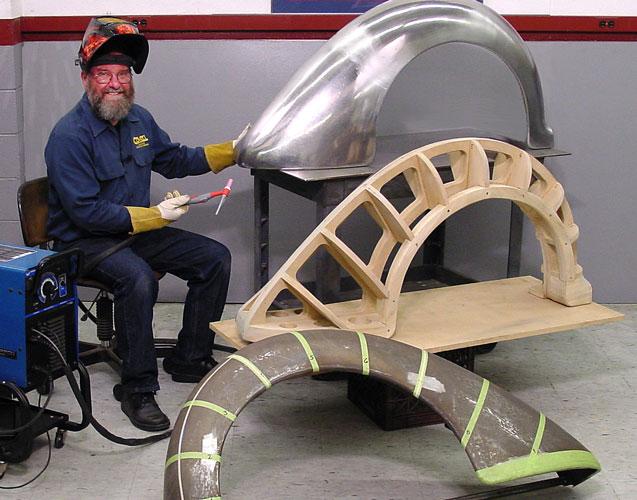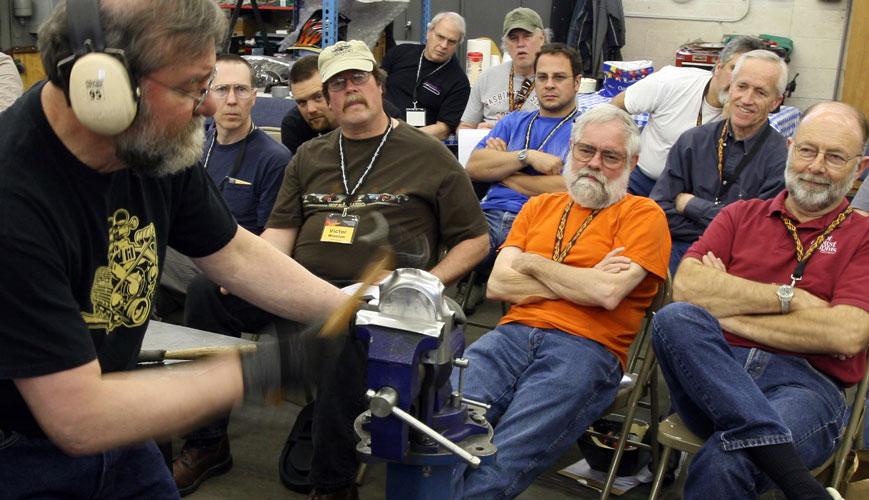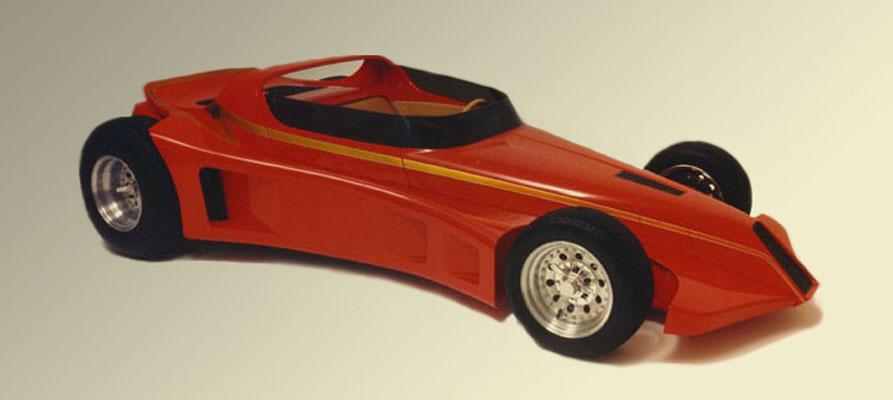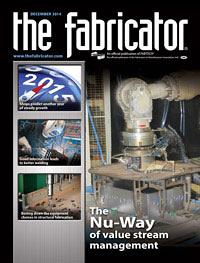- FMA
- The Fabricator
- FABTECH
- Canadian Metalworking
Categories
- Additive Manufacturing
- Aluminum Welding
- Arc Welding
- Assembly and Joining
- Automation and Robotics
- Bending and Forming
- Consumables
- Cutting and Weld Prep
- Electric Vehicles
- En Español
- Finishing
- Hydroforming
- Laser Cutting
- Laser Welding
- Machining
- Manufacturing Software
- Materials Handling
- Metals/Materials
- Oxyfuel Cutting
- Plasma Cutting
- Power Tools
- Punching and Other Holemaking
- Roll Forming
- Safety
- Sawing
- Shearing
- Shop Management
- Testing and Measuring
- Tube and Pipe Fabrication
- Tube and Pipe Production
- Waterjet Cutting
Industry Directory
Webcasts
Podcasts
FAB 40
Advertise
Subscribe
Account Login
Search
Pass it on
Accomplished autobody dynamo values teaching the most
- By Amanda Carlson
- December 12, 2014
- Article
- Bending and Forming

The tools and principles behind hand-shaping metal haven’t changed much throughout the years. One of the benefits of meeting shop owners and other autobody builders through his workshops is watching how people use the same tool in different ways.
If he wanted to, Ron Covell could spend the rest of his days playing golf, taking cruises aboard fine ocean liners with his wife, or pretty much traveling the world. He doesn’t need to build upon his personal or professional resume.
Award-winning work? Check. Higher education degree? Check. Published author? Check. Educational video personality? Notable nickname (“Professor Hammer”)? You guessed it … check and check.
In short, he no longer feels the need to prove himself or his abilities, if he ever even felt a need to begin with.
Covell’s 50-year career manually building autobodies for street rods, dragsters, and motorcycles is impressive, to say the least. But he doesn’t plan on hoarding all of the expertise he’s garnered over the years. His latest passion, of the last 20 years anyway, has been sharing information in his traveling workshops to current or up-and-coming autobody enthusiasts.
It’s what he hopes is his longest and most impactful legacy.
From the Beginning
From the beginning, Covell, like other little boys, loved cars. It became more than just a fascination when he came across a book that had pictures showing how exotic cars like Ferraris and Maseratis were built.
“They weren’t stamped out in presses, they were all hand-shaped by craftsmen using the crudest tools you could imagine—working with wooden mallets and tree stumps. I wanted to learn how to do it,” Covell explained.
Several years later and still a craftsman at heart, Covell enrolled in a collision class at San Jose City College and met a fellow student who was working part-time for Arnie Roberts, who built aluminum bodies for race cars.
Covell spent a quick year and a half soaking up everything his mentor, whom he referred to as a magician, would share, after which he opened his own shop, Covell Creative Metalworking, in Freedom, Calif. His smooth, sleek designs were twice featured on cars at the prestigious Grand National Roadster Show that went on to win the title as America’s Most Beautiful Roadster—the California Star in 1984 and a 1929 Ford roadster in 1992.
He’s written roughly 500 articles for eight magazines and contributes a how-to column for three of them. Somewhere in there he found the time to earn a master’s degree in sculpture from San Jose State University. Unlike the work of most of his classmates, you can drive Covell’s “sculptures.”

From remedial topics to advanced processes, Ron Covell shares his half-century’s worth of autobody-building experience with enthusiasts and craftsmen around the country and internationally. He also provides an online avenue for learning at www.youtube.com/user/covellron.
Teaching the Craft
Both of his parents were teachers, so it’s possible that the teaching gene had always been there. On more than one occasion a friend or a colleague would encourage him to teach a workshop. Finally, Covell obliged.
It was a lot harder than he had planned.
“As a young man I was incredibly shy. So teaching and talking to a group of people really was a challenge for me in the early days. Also, I hadn’t found my voice yet with the processes I was using. I certainly knew how to work each process and with metal very well, but I didn’t know how to convey my process into words that people could understand.
“I found the more I practiced, the more I could put into words the things that my body knew how to do. The more you do anything, the easier it gets. Now I absolutely love it.”
He touches on a variety of topics, including bucks and forms, metal shaping, and working with steel. He tours around the country, even internationally at times, running demos, like making a 1934 Ford rear fender with the hammer forming process, or discussing metallurgy.
Not a whole lot about forming sheet metal by hand has changed. Even after all these years, there are still only three ways to change the shape of a piece of sheet metal: You can stretch it, shrink it, or bend it. One of the perks of traveling to various shops for Covell has been watching other people’s techniques and how they work.
Even now he never misses an opportunity to learn, and then pass it on.
“I think my legacy is going to be more about the way I’ve taught and inspired people to get into this field than the work I’ve done. They’re both important to me, but there’s really been a shift in my life focus. Originally it was shaping metal, and I still love to do that, but I think when I’m gone and if anyone looks back on the work that I’ve done, I think I’m going to have a bigger impact on the teaching and the educating that I’ve done than on the work I’ve done. It might sound crazy, but that’s what I think.”
About the Author

Amanda Carlson
2135 Point Blvd
Elgin, IL 60123
815-227-8260
Amanda Carlson was named as the editor for The WELDER in January 2017. She is responsible for coordinating and writing or editing all of the magazine’s editorial content. Before joining The WELDER, Amanda was a news editor for two years, coordinating and editing all product and industry news items for several publications and thefabricator.com.
subscribe now

The Fabricator is North America's leading magazine for the metal forming and fabricating industry. The magazine delivers the news, technical articles, and case histories that enable fabricators to do their jobs more efficiently. The Fabricator has served the industry since 1970.
start your free subscription- Stay connected from anywhere

Easily access valuable industry resources now with full access to the digital edition of The Fabricator.

Easily access valuable industry resources now with full access to the digital edition of The Welder.

Easily access valuable industry resources now with full access to the digital edition of The Tube and Pipe Journal.
- Podcasting
- Podcast:
- The Fabricator Podcast
- Published:
- 04/30/2024
- Running Time:
- 53:00
Seth Feldman of Iowa-based Wertzbaugher Services joins The Fabricator Podcast to offer his take as a Gen Zer...
- Industry Events
Pipe and Tube Conference
- May 21 - 22, 2024
- Omaha, NE
World-Class Roll Forming Workshop
- June 5 - 6, 2024
- Louisville, KY
Advanced Laser Application Workshop
- June 25 - 27, 2024
- Novi, MI
Precision Press Brake Certificate Course
- July 31 - August 1, 2024
- Elgin,
































